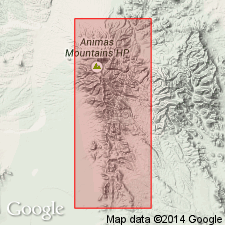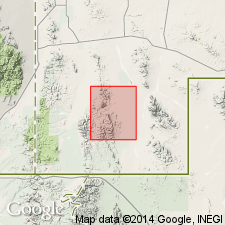
- Usage in publication:
-
- Oak Creek quartz latite tuff
- Modifications:
-
- First used
- Dominant lithology:
-
- Quartz latite
- Tuff
- AAPG geologic province:
-
- Pedregosa basin
Summary:
First use of name. Located in the Animas Range, Walnut Wells quad, Hidalgo Co, NM in Pedregosa basin. Is a quartz latite tuff which surrounds and partially roofs the Animas stock (new); thins away from stock in all directions from a maximum of 1,500 ft or more. Planar structures in the tuff dip away, and phenocrysts in tuff decrease in size and amount when traced away from the stock. Mineral compositions of both phenocrysts and groundmass minerals in the tuff and stock are strikingly similar. Based on this, Oak Creek quartz latite tuff is probably slightly older than intrusive rocks of Animas stock, its probable source. Age given as Tertiary.
Source: GNU records (USGS DDS-6; Denver GNULEX).

- Usage in publication:
-
- Oak Creek Tuff
- Modifications:
-
- Named
- Dominant lithology:
-
- Tuff
- Quartz latite
- AAPG geologic province:
-
- Pedregosa basin
Summary:
Named for exposures near Oak Creek, SE1/4 T30S, R18W, Walnut Wells quad, Hidalgo Co, NM, Pedregosa basin. Geologic map. Is most prominent and oldest exposed formation north of Gillespie Mountain; extends beyond northern quad border. Is 1,500+ ft thick near Valentine Creek, sec 5, T30S, R18W; pinches out south of Gillespie Mountain. Basal part consists of tuffaceous agglomerate and breccia 125 ft thick in most places. Basal beds are heterogeneous, pyroclastic, white, yellow, or light pink, soft, and lack banding; contain lapilli and some bombs. Small clear quartz and lath-like feldspar crystals present. Crystals locally absent. Overlying main mass is green or dark purple and well indurated tuff; contains numerous red and green foreign fragments. Conspicuous streaks and lenses. Weathers to a rusty color. Cliff-forming, with vertical joints not well developed. Upper part is massive, devoid of marker horizons, and uniform. Probably derived from same magma as Animas Quartz Monzonite (new). [During first stage of deposition, 125+ ft of agglomerate and breccia laid down; deposition of 1500+ ft of fragmental viscous tuff followed; upon cooling, vertical jointing developed.] Rests on Cretaceous rocks and Timberlake Fanglomerate with angular unconformity. Overlain by Basin Creek Tuff (new). Is Tertiary in age.
Source: GNU records (USGS DDS-6; Denver GNULEX).
For more information, please contact Nancy Stamm, Geologic Names Committee Secretary.
Asterisk (*) indicates published by U.S. Geological Survey authors.
"No current usage" (†) implies that a name has been abandoned or has fallen into disuse. Former usage and, if known, replacement name given in parentheses ( ).
Slash (/) indicates name conflicts with nomenclatural guidelines (CSN, 1933; ACSN, 1961, 1970; NACSN, 1983, 2005, 2021). May be explained within brackets ([ ]).

